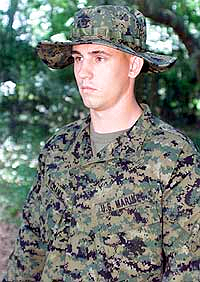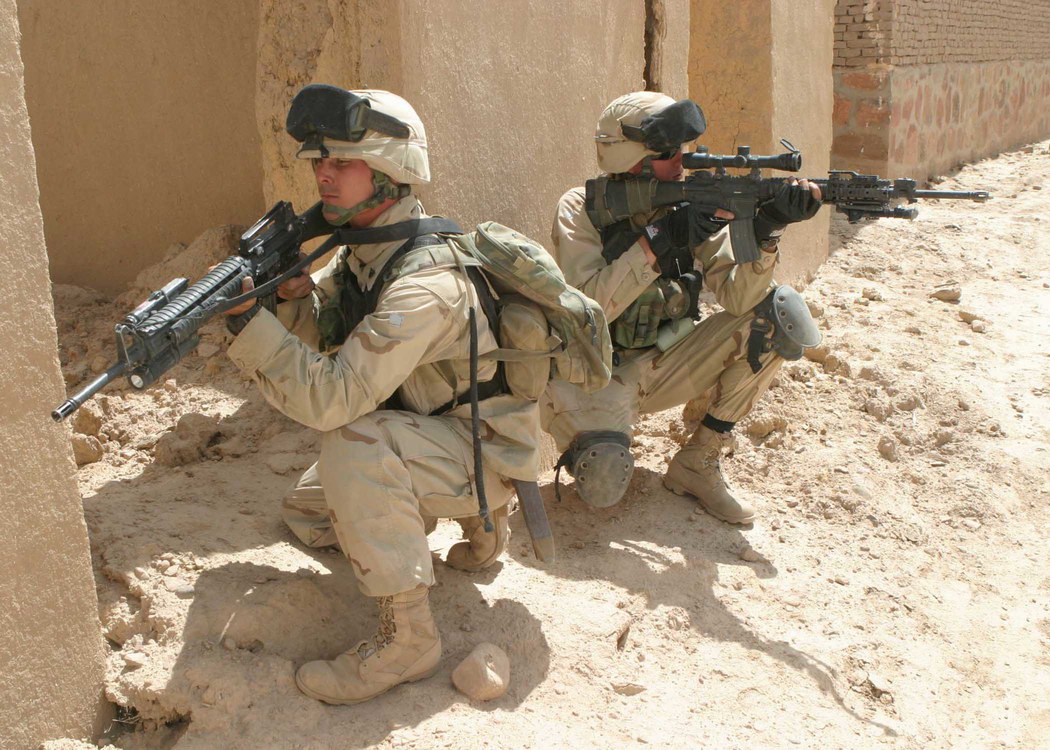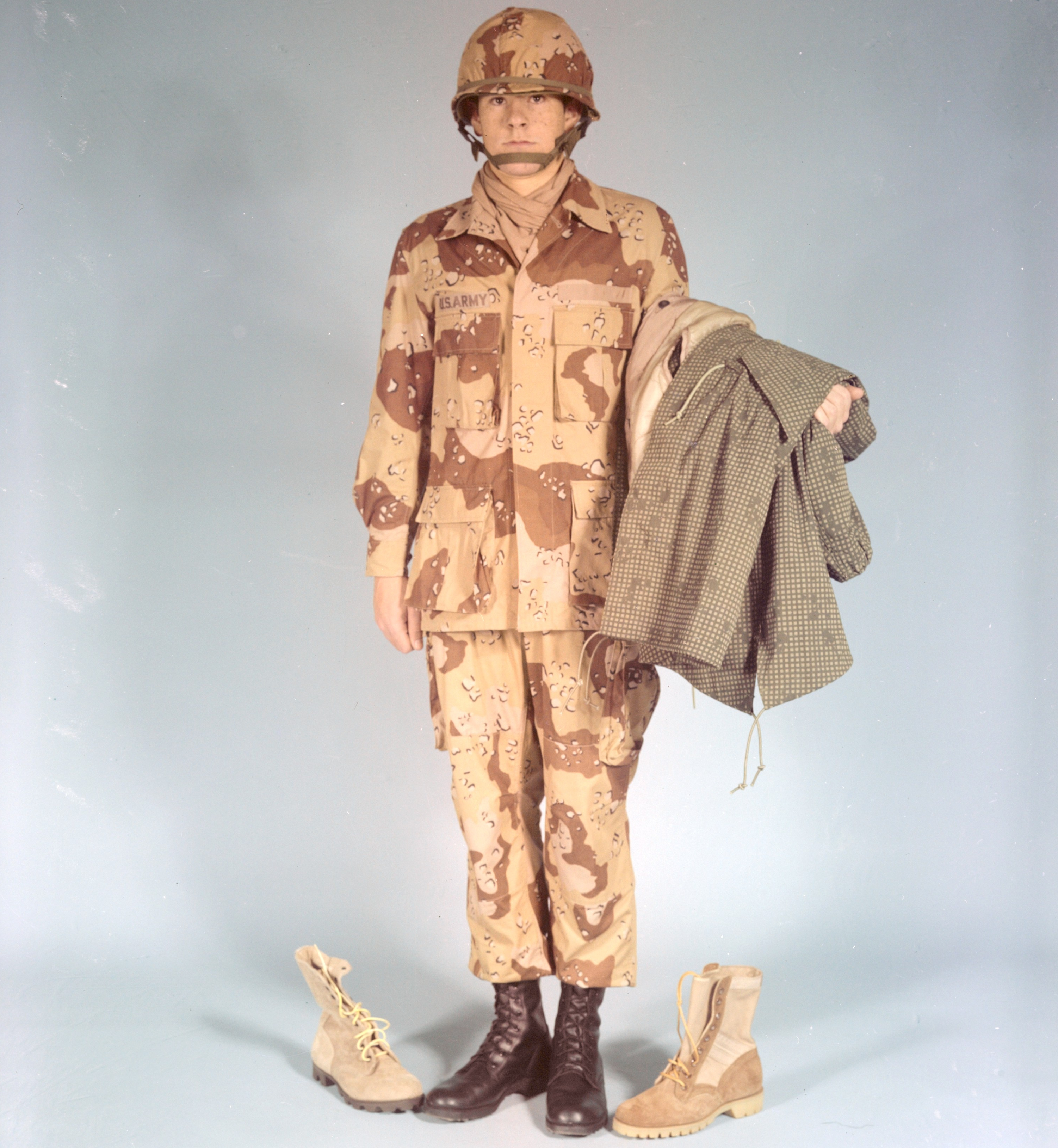|
Desert Night Camouflage
The Desert Night Camouflage pattern is a two-color grid camouflage pattern used by the United States military during the Gulf War. It was designed to aid soldiers in concealment from Soviet-based night vision devices (NVDs). The pattern is now considered obsolete due to the increase in capability of foreign night vision devices. Even with the pattern being obsolete, it has gained interest due to the unusual looks. History During the Persian Gulf War, clothing sets in this pattern were issued to U.S. soldiers, designed to be worn over the issued six-color Desert Battle Dress Uniform during nighttime operations. No night-specific pattern has been created to replace this gear for nighttime use in a desert environment, as advancements in infrared reflectance technology in first the Desert Camouflage Uniform, and finally the Marine Corps Combat Utility Uniform and Army Combat Uniform have eliminated the need for a separate nighttime overgarment. Design The DNC's design was made from ... [...More Info...] [...Related Items...] OR: [Wikipedia] [Google] [Baidu] |
Military Camouflage
Military camouflage is the use of camouflage by an armed force to protect personnel and equipment from observation by enemy forces. In practice, this means applying colour and materials to military equipment of all kinds, including vehicles, ships, aircraft, gun positions and battledress, either to conceal it from observation ( crypsis), or to make it appear as something else ( mimicry). The French slang word ''camouflage'' came into common English usage during World War I when the concept of visual deception developed into an essential part of modern military tactics. In that war, long-range artillery and observation from the air combined to expand the field of fire, and camouflage was widely used to decrease the danger of being targeted or to enable surprise. As such, military camouflage is a form of military deception. Camouflage was first practiced in simple form in the mid 18th century by rifle units. Their tasks required them to be inconspicuous, and they were issued ... [...More Info...] [...Related Items...] OR: [Wikipedia] [Google] [Baidu] |
Marine Corps Combat Utility Uniform
The Marine Corps Combat Utility Uniform (MCCUU) is the current battledress uniform of the United States Marine Corps. It is also worn by Navy personnel (mostly corpsmen, Seabees, chaplains, and their bodyguards) assigned to Marine Corps units (e.g. the Fleet Marine Force). It replaced the Battle Dress Uniform, which the Marine Corps had shared with the Navy, Army and Air Force. However, both the MCCUU, and its distinctive camouflage pattern, MARPAT, are exclusive to the Marine Corps, which holds the patents to their design. The uniform is available in two color schemes, woodland and desert. The MCCUU should not be confused with the similar looking FROG uniform. Development Field testing of the MCCUU began in early 2001 and was officially announced to the public in June 2001. Early prototypes had featured removable sleeves, but that design feature was later abandoned. The patent for the MARPAT pattern was filed on June 19, 2001, whereas the patent for the MCCUU un ... [...More Info...] [...Related Items...] OR: [Wikipedia] [Google] [Baidu] |
United States Military Uniforms
United may refer to: Places * United, Pennsylvania, an unincorporated community * United, West Virginia, an unincorporated community Arts and entertainment Films * ''United'' (2003 film), a Norwegian film * ''United'' (2011 film), a BBC Two film Literature * ''United!'' (novel), a 1973 children's novel by Michael Hardcastle Music * United (band), Japanese thrash metal band formed in 1981 Albums * ''United'' (Commodores album), 1986 * ''United'' (Dream Evil album), 2006 * ''United'' (Marvin Gaye and Tammi Terrell album), 1967 * ''United'' (Marian Gold album), 1996 * ''United'' (Phoenix album), 2000 * ''United'' (Woody Shaw album), 1981 Songs * "United" (Judas Priest song), 1980 * "United" (Prince Ital Joe and Marky Mark song), 1994 * "United" (Robbie Williams song), 2000 * "United", a song by Danish duo Nik & Jay featuring Lisa Rowe Television * ''United'' (TV series), a 1990 BBC Two documentary series * ''United!'', a soap opera that aired on BBC One from 1965-19 ... [...More Info...] [...Related Items...] OR: [Wikipedia] [Google] [Baidu] |
AN/PVS-5
The AN/PVS-5 is a dual-tube night-vision goggle used for aviation and ground support. It uses second-generation image-intensifier tubes. The United States Army still has PVS-5 on supply but are very rarely used. The AN/PVS-5 is based on the SU-50 which was a first-generation night-vision goggle adapted by the United States Air Force in 1971. From 1972 until 1990 the AN/PVS-5 was the mainstay in US Army night vision for aviation. The AN/PVS-5C was not approved for flight because of its auto-gated feature causing the goggle to shut off in bright light. For ground troops the AN/PVS-5 was the sole night-vision goggle until the adaptation of the improved AN/PVS-7. Photographic evidence from Operation Eagle Claw shows US military personnel at Desert One in Iran using in the AN/PVS-5 NVGs. By today's standards the PVS-5 was a safety risk for pilots, issues such as a limited field of view, poor light amplification, inability to read maps, and its excessive weight made it difficult to fly ... [...More Info...] [...Related Items...] OR: [Wikipedia] [Google] [Baidu] |
Battalion
A battalion is a military unit, typically consisting of 300 to 1,200 soldiers commanded by a lieutenant colonel, and subdivided into a number of companies (usually each commanded by a major or a captain). In some countries, battalions are exclusively infantry, while in others battalions are unit-level organizations. The word battalion came into the English language in the 16th century from the French language ( French: ''bataillon'' meaning "battle squadron"; Italian: ''battaglione'' meaning the same thing; derived from the Vulgar Latin word ''battalia'' meaning "battle" and from the Latin word ''bauttere'' meaning "to beat" or "to strike"). The first use of the word in English was in the 1580s. Description A battalion comprises two or more primary mission companies which are often of a common type (e.g., infantry, tank, or maintenance), although there are exceptions such as combined arms battalions in the U.S. Army. In addition to the primary mission companies, a batt ... [...More Info...] [...Related Items...] OR: [Wikipedia] [Google] [Baidu] |
Sniper
A sniper is a military/paramilitary marksman who engages targets from positions of concealment or at distances exceeding the target's detection capabilities. Snipers generally have specialized training and are equipped with high-precision rifles and high-magnification optics, and often also serve as scouts/ observers feeding tactical information back to their units or command headquarters. In addition to long-range and high-grade marksmanship, military snipers are trained in a variety of special operation techniques: detection, stalking, target range estimation methods, camouflage, tracking, bushcraft, field craft, infiltration, special reconnaissance and observation, surveillance and target acquisition. Etymology The name "sniper" comes from the verb "to snipe", which originated in the 1770s among soldiers in British India in reference to shooting snipes, a wader that was considered an extremely challenging game bird for hunters due to its alertness, camouflagi ... [...More Info...] [...Related Items...] OR: [Wikipedia] [Google] [Baidu] |
Reconnaissance
In military operations, reconnaissance or scouting is the exploration of an area by military forces to obtain information about enemy forces, terrain, and other activities. Examples of reconnaissance include patrolling by troops (skirmishers, long-range reconnaissance patrol, U.S. Army Rangers, cavalry scouts, or military intelligence specialists), ships or submarines, crewed or uncrewed reconnaissance aircraft, satellites, or by setting up observation posts. Espionage is usually considered to be different from reconnaissance, as it is performed by non-uniformed personnel operating behind enemy lines. Often called recce (British, Canadian and Australian English) or recon (American English), the word for this activity has at its root the associated verb ''reconnoitre'' or ''reconnoiter''. Etymology The word from the Middle French ''reconoissance''. Overview Reconnaissance conducted by ground forces includes special reconnaissance, armored reconnaissance, amp ... [...More Info...] [...Related Items...] OR: [Wikipedia] [Google] [Baidu] |
Army Combat Uniform
The Army Combat Uniform (ACU) is the current combat uniform worn by the United States Army, U.S. Air Force, and U.S. Space Force. Within U.S. Air Force and U.S. Space Force, it is referred to as the OCP (Operational Camouflage Pattern) Uniform, rather than the Army Combat Uniform. First unveiled in June 2004, it is the successor to the Battle Dress Uniform (BDU) and Desert Camouflage Uniform (DCU) worn from the 1980s and 1990s through to the mid-2000s, respectively. It is also the successor to the Airman Battle Uniform for the U.S. Air Force. History Development In early 2004, some U.S. Army soldiers in Iraq were issued the "Close Combat Uniform", a variant of the Desert Camouflage Uniform (DCU) that featured new features such as shoulder pockets affixed with hook-and-loop "Velcro" fasteners, chest-worn rank insignia, and a new collar. The experimental features used on the CCU were eventually incorporated into the ACU, which was publicly announced in June 2004. Initial fieldi ... [...More Info...] [...Related Items...] OR: [Wikipedia] [Google] [Baidu] |
Desert Camouflage Uniform
The Desert Combat Uniform (DCU) is an arid-environment camouflage uniform that was used by the United States Armed Forces from the mid-1990s to the early 2010s. In terms of pattern and textile cut, it is identical to the U.S. military's Battle Dress Uniform (BDU) uniform, but features a three-color desert camouflage pattern of dark brown, pale olive green, and beige, as opposed to the four-color woodland pattern of the BDU. It replaced the previous Desert Battle Dress Uniform (DBDU) which featured a six-color "chocolate chip" pattern of beige, pale olive green, two tones of brown, and black and white rock spots. Although completely phased out of frontline use in the U.S. Armed Forces, some pieces and equipment printed in the DCU camouflage pattern are used in limited numbers such as MOPP suits and/or vests. History Developed in the late 1980s and first issued in very limited quantity in 1990 as experimental test patterns, the DCU and its camouflage scheme, officially known as th ... [...More Info...] [...Related Items...] OR: [Wikipedia] [Google] [Baidu] |
Desert Night Camouflage
The Desert Night Camouflage pattern is a two-color grid camouflage pattern used by the United States military during the Gulf War. It was designed to aid soldiers in concealment from Soviet-based night vision devices (NVDs). The pattern is now considered obsolete due to the increase in capability of foreign night vision devices. Even with the pattern being obsolete, it has gained interest due to the unusual looks. History During the Persian Gulf War, clothing sets in this pattern were issued to U.S. soldiers, designed to be worn over the issued six-color Desert Battle Dress Uniform during nighttime operations. No night-specific pattern has been created to replace this gear for nighttime use in a desert environment, as advancements in infrared reflectance technology in first the Desert Camouflage Uniform, and finally the Marine Corps Combat Utility Uniform and Army Combat Uniform have eliminated the need for a separate nighttime overgarment. Design The DNC's design was made from ... [...More Info...] [...Related Items...] OR: [Wikipedia] [Google] [Baidu] |
Complex Networks
Complex Networks is an American media and entertainment company for youth culture, based in New York City. It was founded as a bi-monthly magazine, ''Complex'', by fashion designer Marc (Ecko) Milecofsky. Complex Networks reports on popular and emerging trends in style, sneakers, food, music, sports and pop culture. Complex Networks reached over 90 million unique users per month in 2013 across its owned and operated and partner sites, socials and YouTube channels. The print magazine ceased publication with the December 2016/January 2017 issue. Complex currently has 4.55 million subscribers and 1.3 billion total views on YouTube. As of 2019, the company's yearly revenue was estimated to be US$200 million, 15% of which came from commerce. Complex Networks has been named by ''Business Insider'' as one of the Most Valuable Startups in New York, and Most Valuable Private Companies in the World. Complex Networks CEO Rich Antoniello was named among the Silicon Alley 100. In 2012, t ... [...More Info...] [...Related Items...] OR: [Wikipedia] [Google] [Baidu] |
Desert Battle Dress Uniform
The Desert Battle Dress Uniform (DBDU) is a U.S. arid-environment camouflage battle uniform that was used by the United States Armed Forces from the early 1980s to the early to mid 1990s, most notably during the Persian Gulf War. Although the U.S. military has long since abandoned the pattern, it is still in widespread use by militaries across the world as of the early 2020s. Appearance The Desert Battle Dress Uniform was designed in 1976 and uses a camouflage pattern known as the Six-Color Desert Pattern or colloquially as Chocolate-Chip Camouflage and Cookie Dough Camouflage. The camouflage received its nickname because it resembles chocolate-chip cookie dough. It is made up of a base pattern of light tan overlaid with broad swathes of pale green and wide two-tone bands of brown. Clusters of black and white spots are scattered over, to mimic the appearance of pebbles and their shadows. History Although the chocolate-chip camouflage became well known during the Persian Gulf ... [...More Info...] [...Related Items...] OR: [Wikipedia] [Google] [Baidu] |





